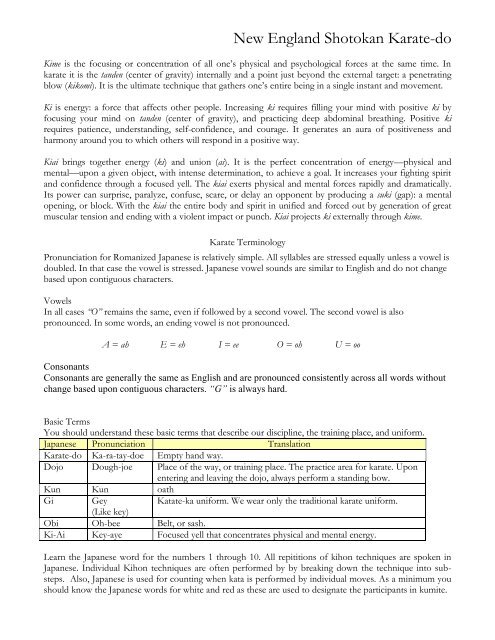Terminology Pages - New England Shotokan Karate
Terminology Pages - New England Shotokan Karate
Terminology Pages - New England Shotokan Karate
You also want an ePaper? Increase the reach of your titles
YUMPU automatically turns print PDFs into web optimized ePapers that Google loves.
<strong>New</strong> <strong>England</strong> <strong>Shotokan</strong> <strong>Karate</strong>-do<br />
Kime is the focusing or concentration of all one‟s physical and psychological forces at the same time. In<br />
karate it is the tanden (center of gravity) internally and a point just beyond the external target: a penetrating<br />
blow (kikomi). It is the ultimate technique that gathers one‟s entire being in a single instant and movement.<br />
Ki is energy: a force that affects other people. Increasing ki requires filling your mind with positive ki by<br />
focusing your mind on tanden (center of gravity), and practicing deep abdominal breathing. Positive ki<br />
requires patience, understanding, self-confidence, and courage. It generates an aura of positiveness and<br />
harmony around you to which others will respond in a positive way.<br />
Kiai brings together energy (ki) and union (ai). It is the perfect concentration of energy—physical and<br />
mental—upon a given object, with intense determination, to achieve a goal. It increases your fighting spirit<br />
and confidence through a focused yell. The kiai exerts physical and mental forces rapidly and dramatically.<br />
Its power can surprise, paralyze, confuse, scare, or delay an opponent by producing a suki (gap): a mental<br />
opening, or block. With the kiai the entire body and spirit in unified and forced out by generation of great<br />
muscular tension and ending with a violent impact or punch. Kiai projects ki externally through kime.<br />
<strong>Karate</strong> <strong>Terminology</strong><br />
Pronunciation for Romanized Japanese is relatively simple. All syllables are stressed equally unless a vowel is<br />
doubled. In that case the vowel is stressed. Japanese vowel sounds are similar to English and do not change<br />
based upon contiguous characters.<br />
Vowels<br />
In all cases “O” remains the same, even if followed by a second vowel. The second vowel is also<br />
pronounced. In some words, an ending vowel is not pronounced.<br />
A = ah E = eh I = ee O = oh U = oo<br />
Consonants<br />
Consonants are generally the same as English and are pronounced consistently across all words without<br />
change based upon contiguous characters. “G” is always hard.<br />
Basic Terms<br />
You should understand these basic terms that describe our discipline, the training place, and uniform.<br />
Japanese Pronunciation Translation<br />
<strong>Karate</strong>-do Ka-ra-tay-doe Empty hand way.<br />
Dojo Dough-joe Place of the way, or training place. The practice area for karate. Upon<br />
entering and leaving the dojo, always perform a standing bow.<br />
Kun Kun oath<br />
Gi Gey<br />
Katate-ka uniform. We wear only the traditional karate uniform.<br />
(Like key)<br />
Obi Oh-bee Belt, or sash.<br />
Ki-Ai Key-aye Focused yell that concentrates physical and mental energy.<br />
Learn the Japanese word for the numbers 1 through 10. All repititions of kihon techniques are spoken in<br />
Japanese. Individual Kihon techniques are often performed by by breaking down the technique into substeps.<br />
Also, Japanese is used for counting when kata is performed by individual moves. As a minimum you<br />
should know the Japanese words for white and red as these are used to designate the participants in kumite.


